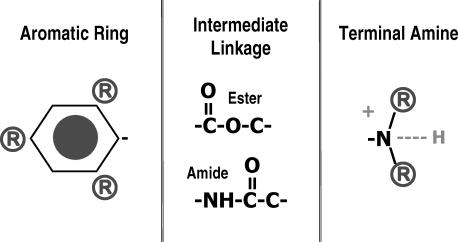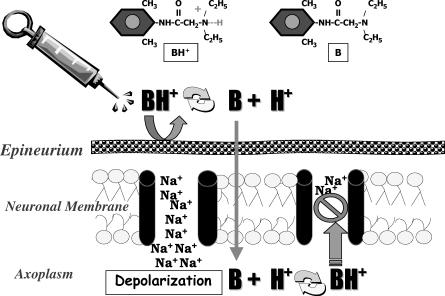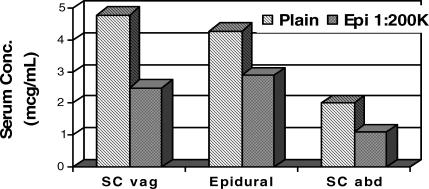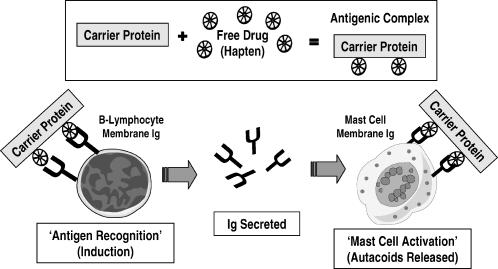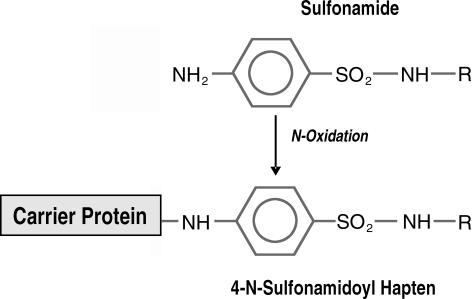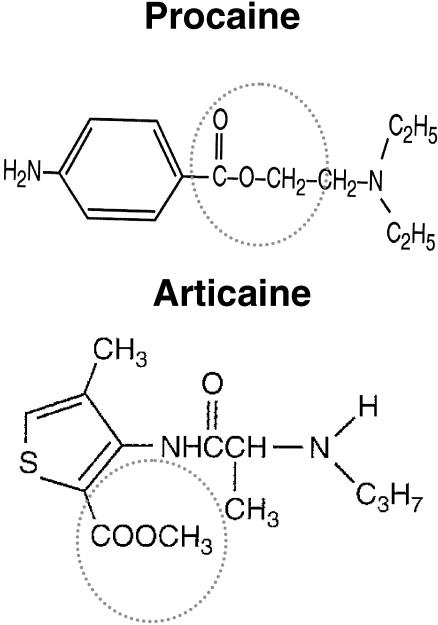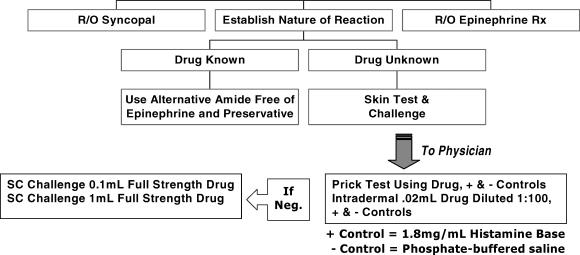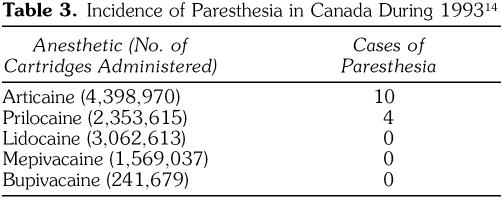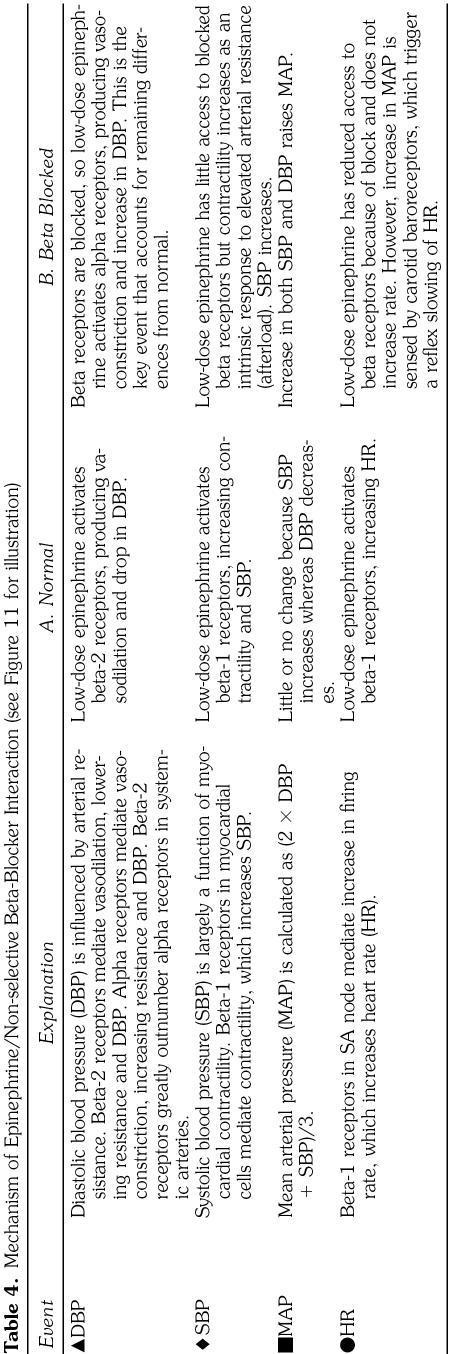Abstract
It is impossible to provide effective dental care without the use of local anesthetics. This drug class has an impressive history of safety and efficacy, but all local anesthetics have the potential to produce significant toxicity if used carelessly. The purpose of this review is to update the practitioner on issues regarding the basic pharmacology and clinical use of local anesthetic formulations.
Keywords: Local anesthetic pharmacology
GENERAL PROPERTIES OF LOCAL ANESTHETICS
Local anesthetics interrupt neural conduction by inhibiting the influx of sodium ions. In most cases, this follows their diffusion through the neural membrane into the axoplasm, where they enter sodium channels and prevent them from assuming an active or “open” state. The local anesthetic molecule consists of 3 components: (a) lipophilic aromatic ring, (b) intermediate ester or amide chain, and (c) terminal amine. Each of these contributes distinct properties to the molecule (Figure 1).
Figure 1.
Local anesthetic structure. All local anesthetics consist of 3 principal components, each contributing a distinct property.
The aromatic ring improves the lipid solubility of the compound, which can be enhanced further by aliphatic substitutions at locations designated (R). Greater lipid solubility enhances diffusion through nerve sheaths, as well as the neural membranes of individual axons comprising a nerve trunk. This property correlates with potency because a greater portion of an administered dose can enter neurons. Because bupivacaine is more lipid soluble than lidocaine, it is more potent and is prepared as a 0.5% concentration (5 mg/mL) rather than a 2% concentration (20 mg/mL).
The terminal amine may exist in a tertiary form (3 bonds) that is lipid soluble or as a quaternary form (4 bonds) that is positively charged and renders the molecule water soluble. As explained above, the aromatic ring determines the actual degree of lipid solubility, but the terminal amine acts as an “on-off switch” allowing the local anesthetic to exist in either lipid-soluble or water-soluble conformations. The tertiary and quaternary forms each play a pivotal role in the sequence of events leading to conduction block.
For the local anesthetic base to be stable in solution, it is formulated as a hydrochloride salt. As such, the molecules exist in a quaternary, water-soluble state at the time of injection. However, this form will not penetrate the neuron. The time for onset of local anesthesia is therefore predicated on the proportion of molecules that convert to the tertiary, lipid-soluble structure when exposed to physiologic pH (7.4). The ionization constant (pKa) for the anesthetic predicts the proportion of molecules that exists in each of these states. By definition, the pKa of a molecule represents the pH at which 50% of the molecules exist in the lipid-soluble tertiary form and 50% in the quaternary, water-soluble form. The pKa of all local anesthetics is >7.4 (physiologic pH), and therefore a greater proportion the molecules exists in the quaternary, water-soluble form when injected into tissue having normal pH of 7.4. Furthermore, the acidic environment associated with inflamed tissues favors the quaternary, water-soluble configuration even further. Presumably, this accounts for difficulty when attempting to anesthetize inflamed or infected tissues; fewer molecules exist as tertiary lipid-soluble forms that can penetrate nerves. In these situations, bupivacaine (pKa 8.1) would be least effective and mepivacaine (pKa 7.6) would be most likely to provide effective anesthesia (Figure 2).
Figure 2.
Local anesthetic action. An injected local anesthetic exists in equilibrium as a quaternary salt (BH+) and tertiary base (B). The proportion of each is determined by the pKa of the anesthetic and the pH of the tissue. The lipid-soluble species (B) is essential for penetration of both the epineurium and neuronal membrane. Once the molecule reaches the axoplasm of the neuron, the amine gains a hydrogen ion, and this ionized, quaternary form (BH+) is responsible for the actual blockade of the sodium channel. Presumably, it binds within the sodium channel near the inner surface of the neuronal membrane.
The intermediate chain or linkage provides a convenient basis for classification and also determines the pattern of biotransformation. Esters are hydrolyzed by plasma esterases, whereas amides are biotransformed in the liver. Esters are no longer packaged in dental cartridges and are used infrequently with the exception of benzocaine, which is found in several topical anesthetic preparations.
Like other drugs, local anesthetics vary in their tendency to bind with plasma proteins. When circulating in the bloodstream, they bind to alpha-1-acid glycoprotein (acidic drugs more likely bind to albumin). This property of protein binding correlates with their affinity for protein within sodium channels and predicts the duration they will sustain neural blockade. Bupivacaine has the greatest percent protein binding and is the longest acting of local anesthetics available in dental cartridges. The clinical performance of local anesthetics correlates with 4 principal characteristics or properties that are summarized in Table 1.
Table 1.
Characteristics and Clinical Correlates
SYSTEMIC TOXICITY
Local anesthetics depress the central nervous system in a dose-dependent manner (see Figure 3). Low serum concentrations are used clinically for suppressing cardiac dysrhythmias and status seizures, but higher concentrations induce seizure activity. Convulsive seizures are the principal life-threatening consequence of local anesthetic overdose. Presumably this is due to selective depression of central inhibitory tracts, which allows excitatory tracts to run amuck. Evidence of lidocaine toxicity may commence at concentrations >5 μg/mL, but convulsive seizures generally require concentrations >8 μg/mL.
Figure 3.
Systemic influences of lidocaine.
In addition to neural blockade, peripheral actions of most local anesthetics include varying degrees of vasodilation, and this contributes to the hypotension observed after administration of large doses. It is essential that local anesthetics be respected as central nervous system depressants, and they potentiate any respiratory depression associated with sedatives and opioids. Furthermore, serum concentrations required to produce seizures are lower if hypercarbia (elevated carbon dioxide) is present. This is the case when respiratory depression is produced by concurrent administration of sedatives and opioids. Goodson and Moore1 have documented catastrophic consequences of this drug interaction in pediatric patients receiving preoperative sedation, along with excessive doses of local anesthetics.
Before we address the variables that influence systemic serum concentrations, please consider the following suggestion for dose calculations. Percent solutions reflect grams of solute (drug) dissolved in 100 mL of solvent. A 3% mepivacaine solution contains 3 g mepivacaine dissolved in each 100 mL of solvent. Converting this to milligrams per milliliter, or milligrams per cartridge, is bothersome. For convenience, use the following suggestions. First of all, consider anesthetic cartridges as containing 2 mL, not 1.8 mL. This error will overestimate the dose and is therefore a safe practice. For a given percent solution, move the decimal 1 place to the right; the resulting number will reflect milligrams per milliliter. For example, 3.0% mepivacaine is 30 mg/mL. A dental cartridge contains 2 mL and therefore contains ~60 mg of mepivacaine. Bupivacaine 0.5% contains 5 mg/mL and therefore ~10 mg per cartridge. After injection of 2½ cartridges of 2% lidocaine it is convenient to consider this as ~5 mL at 20 mg/mL or 100 mg total.
In 1972, Scott et al2 published a study in a series of clinical studies assessing variables that determine subsequent concentrations of local anesthetics in serum. The serum concentration was found to vary according to the route by which the anesthetic is injected. Using lidocaine 400 mg, the highest serum levels illustrated in Figure 4 followed infiltration of vaginal mucosa and the lowest followed subcutaneous abdominal infiltration. In each case, however, peak serum level occurred 20–30 minutes after injection of lidocaine alone. Regardless of the route of administration, peak levels were reduced and the rate of absorption was delayed by adding vasopressors such as epinephrine to the local anesthetic solution. It is reasonable to assume that systemic concentrations after submucosal injection in the oral cavity would approximate those after injection into vaginal mucosa because of similar vascularity.
Figure 4.
Serum concentrations following 3 routes of administration.
Additional variables were also addressed during these landmark studies. As expected, the dose and speed of injection are directly related to ultimate systemic serum concentration. A solution's concentration (eg, 2% vs 3%) is not relevant; the systemic concentration depends on the total dose (eg, 20 mL of 3% or 30 mL of 2% each amount to 600 mg and produce the same serum concentration). When using lidocaine or other anesthetics in concentrations >2%, one must consider the dose (milligrams) administered, not the volume (milliliters or cartridges).
Contrary to conventional thought, the age or weight of a patient does not predict systemic serum concentration following doses calculated as mg/y age or mg/kg. When managing pediatric patients, maximum doses are conventionally expressed in mg/kg, and this should be followed as a precaution. It is of little relevance for adults, however, and one should follow guidelines expressed as maximum dose in milligrams, regardless of weight or age. Obviously, this maximum amount should not be exceeded when calculating doses for large children.
When considering the toxicity of any drug class, one should be mindful of metabolites, as well as the parent drug. Local anesthetics are no exception. Lidocaine is biotransformed in the liver to monoethylglycinexylidide and glycinexylidide. These metabolites have significant activity and have been implicated in cases of lidocaine toxicity after repeated doses and continuous intravenous infusions.
A metabolite of prilocaine, 0-toluidine, can oxidize the iron in hemoglobin from ferrous (Fe2+) to ferric (Fe3+). Hemes so altered do not bind oxygen, and normal hemes on the same hemoglobin molecule do not readily release their oxygen. This form of hemoglobin is called methemoglobin, and when >1% of total hemoglobin is so altered, the condition is called methemoglobinemia. Patients appear cyanotic and become symptomatic when the proportion of methemoglobin exceeds 10 to 15%.3 The condition is rarely life threatening and responds to intravenous methylene blue, which reduces the hemes to their normal state. Methemoglobinemia attributed to prilocaine is unlikely to follow the administration of recommended doses. Rarely, one may encounter a patient with hereditary methemoglobinemia, which contraindicates the use of prilocaine.
ALLERGY TO LOCAL ANESTHETICS
It is not unusual for patients to claim they are allergic to local anesthetics. Upon careful questioning, however, one generally finds that what they experienced was either a syncopal episode associated with the injection or cardiac palpitations attributed to epinephrine either contained in the solution or released endogenously. Although rare, reports of allergic reactions to local anesthetics have appeared in scientific literature, but none of these have confirmed an IgE-mediated hypersensitivity reaction. Nevertheless, patients have occasionally experienced symptoms consistent with an allergic reaction to amide local anesthetics.4,5 In some cases, these episodes have been attributed to preservatives (methylparaben) or antioxidants (bisulfites) contained in the solution.6 Methylparaben is included in multidose vials to prevent microbial growth. It is no longer found in single-dose vials or dental cartridges. Metabisulfites prevent the oxidation of vasopressors and are included only in dental cartridges containing epinephrine or levonordefrin. To clarify several misconceptions regarding allergic reactions, a brief review of their pathogenesis is in order as presented by Adkinson.7
For drugs to be immunogenic, they must be of large molecular weight and possess multiple valences to be recognized by the immune cells. Large proteins such as insulin fulfill these requirements and are well established as immunogenic. Most other molecules are too small and must combine with other molecules that act as carriers, in which case the drug is described as a hapten. This complex of a carrier and hapten can induce and elicit an allergic reaction (Figure 5). Frequently, a metabolite of the drug is the actual molecule that functions as the hapten. This is true for beta lactam and sulfonamide antibiotics. In the case of sulfonamides, the phenyl ring containing an amine substitution is the moiety participating in the formation of the immunogenic complex (Figure 6). This moiety is common to other derivatives of para-aminobenzoic acid (PABA) such as methylparaben and some, but not all, ester local anesthetics. In these cases there may be the potential for cross allergenicity among similar compounds because of a common moiety (eg, sulfa antibiotics, methylparaben, and esters of PABA).
Figure 5.
Carrier + hapten = immunogen.
Figure 6.
Sulfonamide as hapten.
It is careless to describe “esters” as more allergenic than amide local anesthetics. An ester is merely a chemical linkage and imparts no immunogenicity to a compound. Rather, it is a molecular component joined by this linkage that is the culprit. This misconception has caused several agents to be inaccurately labeled as “cross-allergenic” with sulfonamides. Articaine is classified as an amide local anesthetic because of the linkage between its lipid-soluble ring and terminal amine. Its thiophene ring contains a sulfur atom, which has no immunogenic property, and an ester side chain that renders the compound inactive after hydrolysis. However, articaine does not liberate a metabolite resembling PABA and does not introduce concern regarding immunogenicity. In contrast, procaine is representative of esters derived from PABA and hydrolysis liberates a moiety that is potentially immunogenic (Figure 7).
Figure 7.
Ester linkages of procaine and articaine.
A final misconception pertains to sulfites. These are included in local anesthetic solutions containing vasopressors to prevent their oxidation. They are inorganic compounds (−SO3) that have been implicated in allergic reactions, but they have no relation to immunogenicity attributed to PABA-related compounds. These agents are also used as antioxidants in fresh fruits and vegetables to preserve their color and overall appearance. Patients claiming allergy to such foods may experience cross-reactions with local anesthetic solutions containing vasopressors.
Drug reactions with clinical manifestations suggestive of immunological mechanisms, but known to lack an immune basis, are conventionally regarded as “pseudoallergic” reactions. Such reactions are idiosyncratic in mechanism and should be distinguished from true allergy. When these reactions mimic the more severe IgE-independent syndromes, they are described as “anaphylactoid” rather than anaphylactic. Anaphylactoid reactions involve the same final common pathway as true allergy, but the mechanism for the release of the vaso-active mediators is not immune mediated.
If a patient describes a reaction that is clinically consistent with allergy, the dentist should avoid using the offending agent until it is evaluated by an allergist. In the event an anesthetic is required before medical clearance can be obtained, the wisest choice would be either mepivacaine or prilocaine without vasopressors. Conventional wisdom holds that, if local anesthetics do indeed produce allergies, esters of PABA would be capable of cross-reacting, but this would not be likely among amide local anesthetics. Furthermore, by avoiding those solutions containing vasopressors, one avoids bisulfites that are included as antioxidants. Sensitivity to bisulfites is possible, especially among asthmatic or atopic patients. These principles are the basis for the flowchart presented in Figure 8. A patient should never be denied the benefit of local anesthesia because of flawed assumptions regarding allergy.
Figure 8.
Managing patients allergic to local anesthetics. Rule out common reactions misinterpreted as allergy (eg, syncope and tachycardia). Then establish that the nature of their reaction at least resembled a hypersensitivity reaction (eg, rash, pruritus, urticaria, dyspnea). If the drug is known, choose another amide, free of vasopressor so no bisulfites are present. Otherwise, refer to an allergist, sharing this figure if necessary. Adapted from deShazo RD, Kemp SF. JAMA. 1997;278:1903.
LOCAL ANESTHETIC COMPARISONS
Cocaine was the first local anesthetic, discovered in 1860. It is unique among the local anesthetics because, in addition to blocking impulse conduction along axons, it inhibits reuptake of neurotransmitters by adrenergic neuronal endings. Peripherally, this results in an accumulation of norepinephrine within sympathetic synapses leading to vasoconstriction and cardiac stimulation. Centrally, accumulation of norepinephrine results in generalized central nervous system stimulation. However, additional adrenergic neurotransmitters are found within the central nervous system, and their reuptake is inhibited as well. In particular, cocaine's inhibition of dopamine reuptake is pronounced and responsible for its euphoric effect and potential for abuse. For all these reasons, and because it has no greater anesthetic efficacy, cocaine receives little use medically except for topical application during certain ear-nose-throat and ophthalmologic procedures. Because of the potential for added sympathomimetic effects, epinephrine should be avoided when administering local anesthetics to patients suspected of recent cocaine consumption.
Procaine (Novocain) was introduced in 1905 and became the first local anesthetic to gain wide acceptance in the United States. However, its popularity declined after the introduction of lidocaine in 1948. Today, lidocaine is the most widely used agent, but all local anesthetics have comparable efficacy. They differ in potency and several pharmacokinetic parameters that account for differences in the onset and duration of anesthesia. Selection of a particular agent must take into account the duration of the procedure planned and issues regarding vasopressor concentrations. For lengthy procedures, bupivacaine is the logical choice, but it has been implicated as one of the more painful agents during injection according to studies that have compared various anesthetics.8–10 One strategy is to provide the initial 60–90 minutes of anesthesia with a less irritating agent (lidocaine or prilocaine) and then reinject the anesthetized tissue with bupivacaine to provide analgesia well into the postoperative period. Such a strategy is most effective after nerve blocks; shorter duration should be anticipated after soft tissue infiltration. See Table 2 for durations and maximum doses.
Table 2.
Local Anesthetics Available in Cartridges11
Despite anecdotal claims regarding the superiority of articaine (Septocaine, Ultracaine), double-blind studies have confirmed that efficacy is comparable with lidocaine.12,13 Nevertheless, articaine has certain features that make it an attractive choice for selected cases. Unlike other anesthetics having benzene as their aromatic ring, articaine has a thiophene ring, which confers greater lipid solubility than lidocaine. This property should have allowed a lower concentration, but in fact it was formulated as a 4% solution. Claims for successful anesthesia after infiltration of the mandible are likely attributable to high lipid solubility and more molecules per milliliter injected when compared with lidocaine. To date, there have been no published studies comparing articaine with 4% lidocaine solutions for mandibular infiltration. Furthermore, such concentrations of lidocaine present an unacceptable risk for systemic toxicity, and this concern introduces another attractive property of articaine, namely, pattern of clearance.
Although articaine is classified as an amide because of linkage of its intermediate chain, the thiophene ring also contains an ester side chain. This chain is hydrolyzed by plasma esterases rendering the molecule inactive. The result is that articaine has a half-life of only 20 minutes compared with ~90 minutes for lidocaine and other amides that require hepatic clearance. For this reason, articaine presents less risk for systemic toxicity at equipotent doses (eg, 1 cartridge 4% articaine vs 2 cartridges 2% lidocaine). Presumably, this principle would also confer greater safety during lengthy appointments when additional doses of anesthetic must be administered. It should be clarified that articaine is classified molecularly as an amide, not an ester of PABA, and does not present any concern for cross-allergy to PABA derivatives.
The advantages of articaine are tempered somewhat by reports of paresthesia after its use for inferior alveolar blocks. Haas and Lennon14 reported an increased incidence of paresthesias in Canada after the introduction of articaine in the mid 1980s. In 1993 alone, 14 cases of paresthesia were reported, and all were attributed to articaine or prilocaine (see Table 3). Although the overall incidence of paresthesia is low, one cannot discount the increased risk that is apparently associated with higher concentrations of local anesthetics when used for nerve blocks.
Table 3.
Incidence of Paresthesia in Canada During 199314
As part of the approval process for a new drug in the United States, certain data must be submitted to the US Food and Drug Administration. When articaine was being submitted for approval, the following data were part of that application process and are consistent with those of Haas and Lennon.14 The entire text of the document may be found by searching the US Food and Drug Administration web site for the Statistical Review of Application Number 20-971. Looking at study #96001.02US on page 12 of the document, it reads, “Once again, the articaine group appears to have significantly higher risk of paresthesia (10 in 569, vs. 1 in 284 in the lidocaine group).” So, it appears there is a concern with respect to paresthesia when 4% local anesthetic solutions are used. As with all drugs, each practitioner needs to perform a “risk-benefit” analysis before using a medication. Only if the benefit of using articaine outweighs the risk for this practitioner in this patient should it be considered for use. It might be wise to limit the use of these agents for infiltration and reserve their use in nerve blocks for failed attempts with other agents.
MAXIMUM DOSES FOR LOCAL ANESTHETICS
The final issue to be considered is the maximum amount of anesthetic that can be used in a given patient. According to the data originally presented by Scott et al,2 lidocaine 400 mg injected submucosally produces systemic serum concentrations well below toxic levels. This is approximately the amount found in 10 anesthetic cartridges, and this number is conventionally cited as the limit per dental appointment. Summaries of these studies, and others regarding additional local anesthetics, are the basis for the maximum recommended doses listed in Table 2. But current information has not addressed issues regarding lengthy dental procedures that may well outlast the duration of anesthesia provided by conventional agents. In such cases, decisions regarding additional doses must be predicated on empiric judgment.
The serum half-life (T1/2) of the various local anesthetics ranges from 90 minutes for conventional agents such as lidocaine to nearly 300 minutes for agents such as bupivacaine. This decline commences after peak concentration is achieved and declines after approximately 20–30 minutes with anesthetics alone. (The time to peak concentration when combined with vasopressors is not well documented, but adding an additional 10–15 minutes would be a reasonable estimate.) Once the peak concentration is achieved, additional doses will absorb as original doses are in decline. This is a perilous time because one cannot accurately predict the serum concentration at any period. Additionally, individual patient values cannot be absolutely known because of the bell-shaped pattern of distribution for patient responses and renders these theoretical calculations even more problematic. However, given the fact that solutions containing vasopressors are absorbed slowly and their peak concentrations are reduced, it seems reasonable to assume that doses that do not exceed one fourth of the maximum permissible dose listed in Table 2 could be administered during each subsequent hour of treatment. This suggestion presumes the patient has adequate hepatic perfusion and function and is not medicated with agents that delay hepatic clearance. During lengthy procedures, however, one should anesthetize and complete treatment in one region before anesthetizing another. By following this principle, it is rarely necessary to exceed maximum recommended limits. When using a combination of agents, guidelines for maximum doses should be regarded as additive. For example, if half the maximum dose for lidocaine has been administered, it would be safe to administer up to half the maximum dose for mepivacaine.
VASOPRESSORS
Vasopressors are combined with local anesthetics to provide local hemostasis in the operative field and to delay their absorption. Delayed absorption of local anesthetics not only reduces the risk for systemic toxicity, but also prolongs the duration of anesthesia. Epinephrine is the most common agent used for this purpose, despite the fact that it exhibits considerable cardiac stimulation because of its beta-1 agonistic action in addition to its desired vasoconstrictive activity (alpha-1 agonistic action).
Despite the popularity of epinephrine 1 : 100,000, concentrations >1 : 200,000 (5 μg/mL) offer no advantage in terms of prolonging anesthesia or reducing serum concentrations of local anesthesia. Higher concentrations do not provide better onset or duration for inferior alveolar nerve block15,16 or reduce local anesthetic serum concentrations.2 However, greater concentrations (eg, 1 : 100,000 [10 μg/mL] and 1 : 50,000 [20 μg/mL]) may provide better hemostasis at the surgical site when this influence is desired.
To properly address safety issues regarding vasopressors, one must first appreciate principles of dose calculations. Solutions expressed as ratios represent grams of solute (drug) dissolved in milliliters of solvent. A 1 : 100,000 concentration of epinephrine contains 1 g epinephrine dissolved in 100,000 mL solvent. Converting this to milligrams or micrograms per milliliter is time consuming. This concentration is most common in local anesthetic solutions and is best memorized as 10 μg/mL. If one accepts the earlier suggestion that cartridges contain 2 mL, it follows that a cartridge of local anesthetic combined with epinephrine 1 : 100,000 contains ~20 μg epinephrine. Simply double this amount when using solutions that contain epinephrine 1 : 50,000, and halve those containing epinephrine in concentrations of 1 : 200,000.
There is continued debate regarding deleterious influences of vasopressors on patients with cardiovascular disease. Clinical trials have confirmed unequivocally that even small doses of epinephrine in local anesthetic solutions have an influence on cardiovascular function (see Figure 9). Dionne et al17 studied the influence of 3 cartridges of 2% lidocaine with epinephrine 1 : 100,000 (~60 μg or precisely 54 μg epinephrine). Submucosal injection of this dose increased cardiac output, heart rate, and stroke volume. Peripheral resistance was reduced, and mean arterial pressure remained essentially unchanged. This finding was consistent with that according to 10 μg/min epinephrine infusions presented in standard texts.18 The issue we must address is whether these influences pose a significant risk to patients with cardiovascular diseases. Putative standards and guidelines continue to be presented but in fact are all anecdotal. Ultimately, the decision requires the dentist to exercise sound clinical judgment based on a thorough analysis of each patient under consideration. If consultation with the patient's physician is indicated, discuss the anticipated dose range in terms of micrograms, not concentrations or cartridges. For example, if 2–4 cartridges of local anesthetic are planned, explain that you will be using 40–80 μg of epinephrine infiltrated sub-mucosally, not 2–4 cartridges of epinephrine 1 : 100,000. The physician is unfamiliar with a dose expressed as cartridges or concentrations. As reference, consider the conventional epinephrine dose for allergic reactions is 0.3 mg or 300 μg.
Figure 9.
Cardiovascular influences of epinephrine. Patients received submucosal infiltration of 3 cartridges (5.4 mL) of 2% lidocaine and 2% lidocaine with epinephrine 1 : 100,000. Changes in cardiovascular parameters were recorded as percent change. Heart rate (HR), stroke volume (SV), and cardiac output (CO) determine systolic blood pressure. Peripheral resistance (PR) determines diastolic blood pressure. Mean arterial pressure (MAP) is calculated as (SBP + 2 × DBP)/3. Adapted from Dionne et al.17
Levonordefrin (NeoCobefrin) is the vasopressor combined with 2% mepivacaine solutions in the United States. It closely resembles norepinephrine rather than epinephrine and lacks activity at Beta2 receptors. Epinephrine increases heart rate and systolic pressure but lowers diastolic pressure. In contrast, systemic administration of norepinephrine increases systolic, diastolic, and mean arterial pressures, and this triggers a reflex slowing of heart rate.18 (This is illustrated and explained in Figure 10.) Levonordefrin has been suggested as an alternative to epinephrine-containing local anesthetics when treating patients with cardiovascular heart disease because it does not increase heart rate. However, advocates fail to consider its undesirable influence on blood pressure. The 1 : 20,000 levonordefrin concentration found in mepivacaine is considered equipotent to standard 1 : 100,000 epinephrine concentrations in terms of alpha receptor activity (vasoconstriction). After infiltration, they have equivalent efficacy for constricting submucosal vessels, and their influences on local hemorrhage and anesthetic absorption are similar.
Figure 10.
Cardiovascular influences of norepinephrine (and levonordefrin) versus epinephrine.18 A. Both drugs stimulate Beta1 receptors on cardiac muscle, which increase myocardial contractility. This results in an increase in systolic pressure. B. Both drugs stimulate alpha receptors on vessels, which causes them to constrict. Submucosal vessels contain only alpha receptors, so both drugs produce local vasoconstriction when injected submucosally. But submucosal vessels are not illustrated here; they do not influence diastolic pressure. Systemic arteries influence diastolic pressure and contain Beta2 receptors, which vasodilate and are far more numerous than alpha receptors. Norepinephrine has no affinity for Beta2 receptors and constricts systemic arteries by activating the alpha receptors, even though they are less numerous. This increases diastolic pressure. Epinephrine, which has Beta2 as well as alpha receptor activity, produces vasodilation and a reduction in diastolic pressure. C. Both drugs stimulate Beta1 receptors on the Sino-atrial node, which increases heart rate. But this potential effect from norepinephrine is overridden by a reflex explained as follows. Notice that epinephrine has no influence on mean arterial pressure; systolic pressure increases but diastolic decreases and negates any effect on mean arterial pressure. Norepinephrine increases systolic, diastolic, and mean arterial pressures. The increase in mean arterial pressure stimulates baroreceptors in the carotid sinus, which trigger a vagal slowing of heart rate.
Misconceptions regarding adverse interactions between vasopressors and antidepressants persist despite literature that dispels this concern. Most of these concerns relate to pharmacokinetic interactions predicated on clearance of catecholamines. Although neuronal uptake is the principal method for termination of endogenous adrenergic neurotransmitters, hepatic biotrans-formation is the principal pathway for termination of exogenously administered adrenergic drugs.18 Most noncatecholamines are metabolized in liver by mono-amine oxidase, but those having a catecholamine structure are primarily inactivated by catechol-o-methyltransferase. Epinephrine and levonordefrin are catechol-amines and are metabolized primarily by catechol-o-methyltransferase, not monoamine oxidase or neuronal uptake.18,19 Patients treated with monoamine oxidase inhibitors are not hindered in clearing either of these vasopressors.11 Newer antidepressants (eg, fluoxetine [Prozac]) selectively inhibit serotonin reuptake and likewise are not a concern. Although they are not contra-indicated entirely, vasopressors should nevertheless be used with caution in patients receiving tricyclic antidepressants. This particular class of antidepressants has an ability to produce cardiac arrhythmias, which could be potentiated by a similar tendency shared by all sympathomimetic agents. For these patients, vital signs should be monitored continually if more than 1 or 2 cartridges containing any vasopressor are used.
Patients medicated with nonselective beta-blocking agents have heightened sensitivity to the systemic effects of vasopressors.20 Beta blockers are used for their ability to block sympathetic influences on cardiac Beta1 receptors. Unfortunately, older agents are nonselective and also block Beta2 receptors on systemic arteries. This offsets the tendency of epinephrine to dilate and instead increases systemic vascular resistance. Blood pressure increases dramatically and is followed by a reflex slowing of heart rate. The mechanism of this interaction is detailed in Figure 11 and Table 4. Numerous reports of stroke and cardiac arrest have been reported in medical literature warning of this potential interaction.21,22 Hypertensive responses have been reported after low doses of both epinephrine and levonordefrin.23 It is significant that this interaction will not occur in those patients receiving selective beta1 antagonists because, at conventional doses, these have little or no affinity for vascular beta2 receptors. However, caution is still advised because putative selectivity for beta1 receptors may not be absolute, especially in patients medicated with high doses. The following are 2 guidelines to consider when using vasopressors in patients medicated with beta blockers:
Avoid the use of vasopressors, if reasonable.
If a vasopressor is to be used, record blood pressure and heart rate, then proceed as follows: (a) after the injection of each cartridge, pause 5 minutes and reassess vital signs before administering any additional local anesthetic; or (b) infiltrate the entire region to be treated by using a cartridge to provide constriction of local vessels, then reinject the region with a local anesthetic free of vasopressor.
Figure 11.
Mechanism of epinephrine–beta-blocker interaction. The cardiovascular influences of epinephrine are mediated via alpha, Beta-1, and Beta-2 receptors and are altered in patients medicated with nonselective beta blockers. These graphs distinguish typical cardiovascular responses after a 10-to 20-μg test dose of epinephrine in a normal versus a beta-blocked patient (see Table 4 for additional explanation). Note that the key underlying mechanism involves the influence of epinephrine on systemic vascular resistance and subsequent diastolic blood pressure (DBP).
Table 4.
Mechanism of Epinephrine/Non-selective Beta-Blocker Interaction (see Figure 11 for illustration)
Finally, some consideration should be given to maximum permissible doses of vasopressors. To express limits in terms of appointments is impractical; time of treatment may be as brief as 30 minutes or as long as 3–4 hours. The influence of a given dose of epinephrine among patients is highly variable. Peak serum levels of epinephrine after submucosal injection are generally achieved within 5 minutes and decline rapidly due to inactivation by catechol-o-methyltransferase. Generally, the hemodynamic influences of epinephrine are witnessed within minutes of injection and have completely subsided in 20 minutes. A dose of 40 μg (approximately 2 cartridges containing epinephrine 1 : 100,000) is the most conservative and frequently cited dose limitation for epinephrine in patients with significant cardiovascular disease. It should be clarified that this guideline more accurately reflects 30-minute time periods, not appointments. A more reasonable suggestion should be based on patient assessment, not maximal dose. If for any reason the medical status of a patient is in question, reassess vital signs within 5 minutes after the administration of each cartridge. If the patient is stable, additional doses may be administered followed by a similar pattern of reassessment.
CONTINUING EDUCATION QUESTIONS
- Beckercaine is a newly released local anesthetic classified as an ester and is compounded with epinephrine 1 : 200,000. It has twice the lipid solubility of lidocaine, and other data are as follows, with corresponding data for lidocaine in parentheses: pKa = 7.5 (7.9) Protein binding 92% (65%). All of the following are correct regarding this new wonder-drug EXCEPT:
- It is likely formulated as a 1% solution.
- It has a faster onset than lidocaine.
- It is metabolized in plasma.
- It has a shorter duration than lidocaine.
- Which of the following reflect accurate doses contained in 5 mL (~2.5 cartridges) prilocaine 4% with 1 : 200,000 epinephrine?
- Prilocaine 20 mg; epinephrine 50 μg.
- Prilocaine 200 mg; epinephrine 25 μg.
- Prilocaine 20 mg; epinephrine 25 μg.
- Prilocaine 200 mg; epinephrine 10 μg.
- Hypertensive events attributed to drug interaction have occurred after the administration of local anesthetics containing epinephrine in patients medicated with which of the following?
- Nonselective beta blockers.
- MAOI antidepressants.
- SSRI antidepressants.
- a and b are correct.
- a, b, and c are correct.
- The maximum recommended dose is 500 mg for lidocaine with epinephrine and 400 mg for mepivacaine. Anesthesia is difficult to obtain, and you have administered 6 cartridges of 2% lidocaine with epinephrine to remove 4 third molars. Two sites remain sensitive, and you elect to reinject with 3% mepivacaine to avoid more epinephrine. Which of the following number of cartridges would be the maximum number you can safely administer? (Assume 2 mL per cartridge.)
- 1
- 3
- 5
- 7
REFERENCES
- Goodson JM, Moore PA. Life-threatening reactions after pedodontic sedation: an assessment of narcotic, local anesthetic and antiemetic drug interactions. J Am Dent Assoc. 1983;107:239–245. doi: 10.14219/jada.archive.1983.0225. [DOI] [PubMed] [Google Scholar]
- Scott DB, Jebson PJR, Braid DP, et al. Factors affecting plasma levels of lignocaine and prilocaine. Br J Anaesth. 1972;44:1040–1049. doi: 10.1093/bja/44.10.1040. [DOI] [PubMed] [Google Scholar]
- Prchal JT, Gregg X. Hemoglobinopathies: methemoblobinemias, polycythemias and unstable hemoglobins. In: Goldman L, Ausiello D, editors. Cecil Textbook of Medicine. 22nd ed. Philadelphia, Pa: WB Saunders Co; 2004. [Google Scholar]
- Gall H, Kaufmann R, Kalveram CM. Adverse reactions to local anesthetics: analysis of 197 cases. J Allergy Clin Immunol. 1996;97:933–937. doi: 10.1016/s0091-6749(96)80067-4. [DOI] [PubMed] [Google Scholar]
- Berkun Y, Ben-Zvi A, Levy Y, Galili D, Shalit M. Evaluation of adverse reactions to local anesthetics: experience with 236 patients. Ann Allergy Asthma Immunol. 2003;91:342–345. doi: 10.1016/S1081-1206(10)61680-8. [DOI] [PubMed] [Google Scholar]
- Schatz M. Adverse reactions to local anesthetics. Immunol Allergy Clin North Am. 1992;12:585–609. [Google Scholar]
- Adkinson NF., Jr . Drug allergy. In: Adkinson NF Jr, Yunginger JW, Busse WW, editors. Middleton’s Allergy: Principles and Practice. 6th ed. Philadelphia, Pa: Mosby Inc; 2003. et al, eds. [Google Scholar]
- Morris R, McKay W, Mushlin P. Comparison of pain associated with intradermal and subcutaneous infiltration with various local anesthetic solutions. Anesth Analg. 1987;66:1180–1182. [PubMed] [Google Scholar]
- Wahl MJ, Overton D, Howell J, Siegel E, Schmitt MM, Muldoon M. Pain on injection of prilocaine plain vs. lidocaine with epinephrine. A prospective double-blind study. J Am Dent Assoc. 2001;132:1396–1401. doi: 10.14219/jada.archive.2001.0054. [DOI] [PubMed] [Google Scholar]
- Wahl MJ, Schmitt MM, Overton DA, Gordon MK. Injection pain of bupivacaine with epinephrine vs. prilocaine plain. J Am Dent Assoc. 2002;133:1652–1656. doi: 10.14219/jada.archive.2002.0115. [DOI] [PubMed] [Google Scholar]
- Yagiela JA. Local anesthetics. In: Dionne RA, Phero JP, Becker DE, editors. Management of Pain & Anxiety in the Dental Office. St Louis, Mo: WB Saunders/Elsevier Science; 2002. [Google Scholar]
- Malamed SF, Gagnon S, Leblanc D. Efficacy of articaine: a new amide local anesthetic. J Am Dent Assoc. 2000;131:635–642. doi: 10.14219/jada.archive.2000.0237. [DOI] [PubMed] [Google Scholar]
- Mikesell P, Nusstein J, Reader A, Beck M, Weaver J. A comparison of articaine and lidocaine for inferior alveolar nerve blocks. J Endod. 2005;31:265–270. doi: 10.1097/01.don.0000140576.36513.cb. [DOI] [PubMed] [Google Scholar]
- Haas DA, Lennon D. A 21 year retrospective study of reports of paresthesia following local anesthetic administration. J Can Dent Assoc. 1995;61:319–330. [PubMed] [Google Scholar]
- Dagher FB, Yared GM, Machtou P. An evaluation of 2% lidocaine with different concentrations of epinephrine for inferior alveolar nerve block. J Endod. 1997;23:178–180. doi: 10.1016/S0099-2399(97)80271-3. [DOI] [PubMed] [Google Scholar]
- Tofoli GR, Ramacciato JC, de Oliveira PC. Comparison of effectiveness of 4% articaine associated with 1: 100,000 or 1:200,000 epinephrine in inferior alveolar nerve block. Anesth Prog. 2003;50:164–168. et al. [PMC free article] [PubMed] [Google Scholar]
- Dionne RA, Goldstein DS, Wirdzek PR. Effects of diazepam premedication and epinephrine-containing local anesthetic on cardiovascular and catecholamine responses to oral surgery. Anesth Analg. 1984;63:640–646. [PubMed] [Google Scholar]
- Hoffman BB. Catecholamines, sympathomimetic drugs, and adrenergic receptor antagonists. In: Hardman JG, Limbird LE, Gilman AG, editors. Goodman and Gilman’s The Pharmacological Basis of Therapeutics. 10th ed. New York, NY: McGraw-Hill; 2001. [Google Scholar]
- Lawson NW, Meyer DJ. Autonomic nervous system physiology and pharmacology. In: Barash PG, Cullen BF, Stoelting RK, editors. Clinical Anesthesia. 3rd ed. Philadelphia, Pa: JB Lippincott Co; 1997. [Google Scholar]
- Becker DE. Clinical implications of autonomic pharmacology. J Oral Maxillofac Surg. 1992;50:734–740. doi: 10.1016/0278-2391(92)90109-d. [DOI] [PubMed] [Google Scholar]
- Foster CA, Aston SJ. Propranolol-epinephrine interaction: a potential disaster. Plast Reconstr Surg. 1983;72:74–78. doi: 10.1097/00006534-198307000-00017. [DOI] [PubMed] [Google Scholar]
- Gandy W. Severe epinephrine-propranolol interaction. Ann Emerg Med. 1989;18:98–99. doi: 10.1016/s0196-0644(89)80324-5. [DOI] [PubMed] [Google Scholar]
- Mito RS, Yagiela JA. Hypertensive response to levonordefrin in a patient receiving propranolol: report of a case. J Am Dent Assoc. 1988;116:55–57. doi: 10.14219/jada.archive.1988.0155. [DOI] [PubMed] [Google Scholar]



